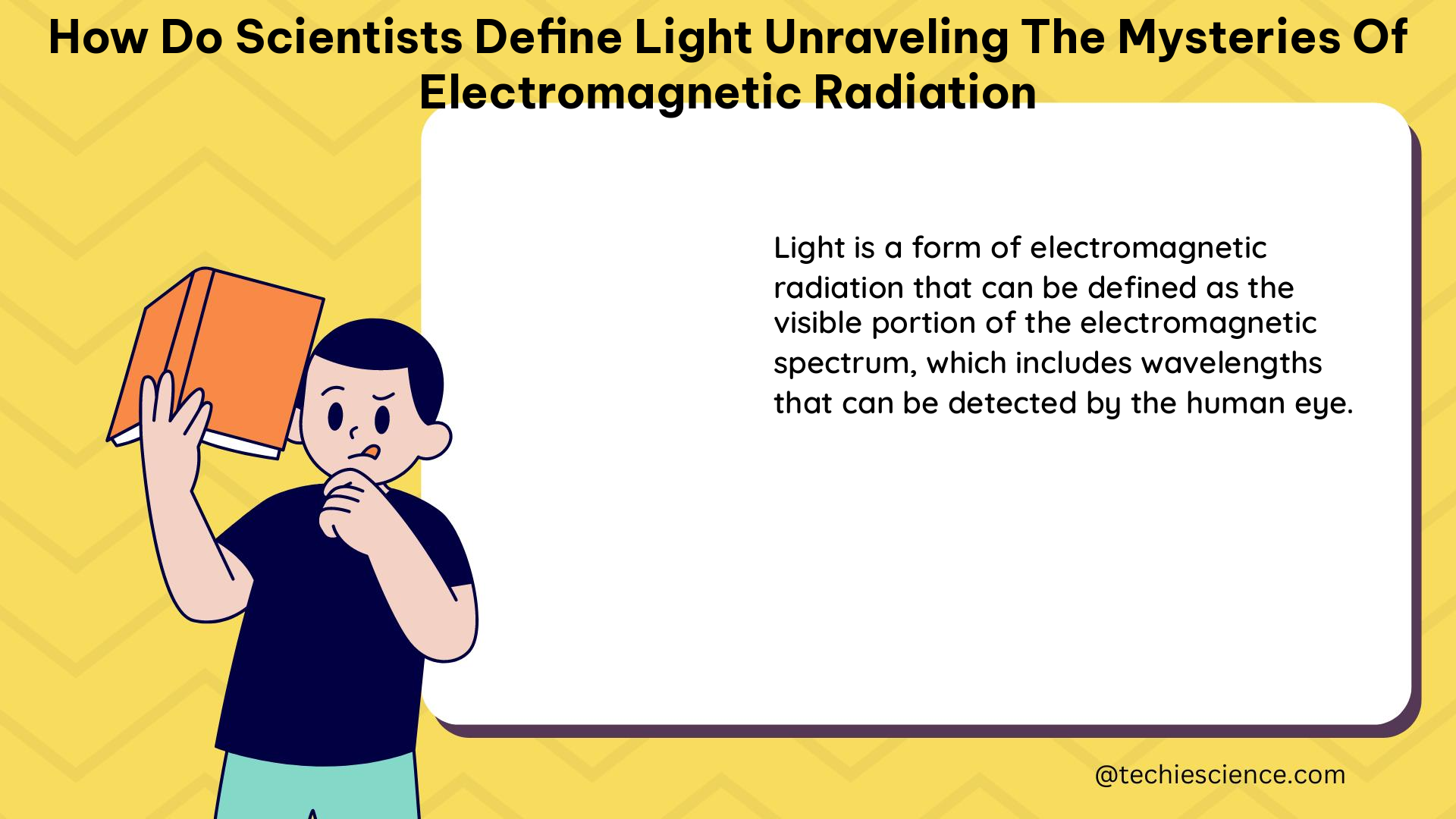Scientists define light as a form of electromagnetic radiation, which is a type of energy characterized by the presence of electric and magnetic fields. This blog post delves into the technical details and advanced concepts surrounding the scientific understanding of light and electromagnetic radiation.
The Fundamental Properties of Light
Light, as a form of electromagnetic radiation, is defined by three key properties: wavelength, frequency, and energy. These properties are interconnected and can be described by the following equations:
- Wavelength-Frequency Relationship: The relationship between the wavelength (λ) and frequency (ν) of light is given by the equation:
c = λν
where c is the speed of light, approximately 3 × 10^8 m/s.
- Photon Energy: The energy (E) of a photon, the smallest unit of electromagnetic radiation, is given by the equation:
E = hf
where h is Planck’s constant, approximately 6.626 × 10^-34 J⋅s, and f is the frequency of the photon.
These fundamental relationships allow scientists to understand and quantify the various properties of light and electromagnetic radiation.
The Electromagnetic Spectrum

The electromagnetic spectrum is the classification of electromagnetic radiation based on its wavelength and frequency. The different regions of the electromagnetic spectrum include:
| Region | Wavelength Range | Frequency Range |
|---|---|---|
| Gamma Rays | < 0.01 nm | > 30 EHz |
| X-Rays | 0.01 – 10 nm | 30 EHz – 30 PHz |
| Ultraviolet (UV) | 10 – 400 nm | 30 PHz – 750 THz |
| Visible Light | 400 – 700 nm | 430 – 750 THz |
| Infrared (IR) | 700 nm – 1 mm | 300 GHz – 430 THz |
| Microwaves | 1 mm – 1 m | 300 MHz – 300 GHz |
| Radio Waves | > 1 m | < 300 MHz |
The visible light region, which is the only part of the electromagnetic spectrum that can be detected by the human eye, spans wavelengths from approximately 400 nanometers (violet) to 700 nanometers (red).
Wave-Particle Duality of Light
Light exhibits a fundamental property known as wave-particle duality, which means that it can behave both as a wave and as a particle. This duality is demonstrated by the photoelectric effect, where the emission of electrons from a material is observed when it is illuminated by light.
The photoelectric effect can only be explained by assuming that light consists of discrete packets of energy, called photons, which have both wave-like and particle-like properties. This concept challenges the classical wave theory of light and was a key contribution to the development of quantum mechanics.
The Magnetic Aspect of Light
Recent research has uncovered a previously overlooked connection between light and magnetism. This discovery challenges the conventional understanding of light as solely an electric field phenomenon and suggests that light also has a magnetic component.
The implications of this finding include the potential development of:
- Ultra-fast Memory Technologies: Light-controlled magnetic memory devices that can operate at much faster speeds than current electronic memory.
- Pioneering Sensors: Sensors capable of detecting the magnetic components of light, which could lead to advancements in various fields, such as medical imaging and telecommunications.
This research highlights the ongoing efforts to unravel the mysteries of electromagnetic radiation and expand our understanding of the fundamental nature of light.
Practical Applications of Light and Electromagnetic Radiation
The various properties and regions of the electromagnetic spectrum have numerous practical applications in our daily lives and scientific research, including:
- Visible Light: Used in illumination, photography, and various optical technologies.
- Infrared (IR): Used in remote controls, night vision, and thermal imaging.
- Ultraviolet (UV): Used in disinfection, tanning, and materials curing.
- X-Rays: Used in medical imaging and material analysis.
- Microwaves: Used in radar, telecommunications, and microwave ovens.
- Radio Waves: Used in radio and television broadcasting, wireless communication, and radio astronomy.
These applications demonstrate the widespread impact of our understanding of light and electromagnetic radiation on modern technology and scientific exploration.
Conclusion
In summary, scientists define light as a form of electromagnetic radiation that is characterized by its wavelength, frequency, and energy. Light exhibits the fundamental property of wave-particle duality, which has been crucial in the development of quantum mechanics. Recent research has also uncovered a previously unknown connection between light and magnetism, opening up new avenues for technological advancements.
The comprehensive understanding of light and electromagnetic radiation continues to evolve, with scientists constantly unraveling the mysteries and exploring the practical applications of this fundamental aspect of our physical world.
Reference:
– Unraveling the Mysteries of Electromagnetic Radiation – YouTube. Available at: https://www.youtube.com/watch?v=DhKv431BMJM
– 5 Scientists Who Contributed to Electromagnetism. Available at: https://www.discovermagazine.com/the-sciences/5-scientists-who-contributed-to-electromagnetism
– Scientists Discover Groundbreaking Connection Between Light and Magnetism. Available at: https://scitechdaily.com/challenging-conventional-understanding-scientists-discover-groundbreaking-connection-between-light-and-magnetism/
– DOE Explains…Photons – Department of Energy. Available at: https://www.energy.gov/science/doe-explainsphotons
– Unraveling Electromagnetic Field Principles for Physics Scholars. Available at: https://www.ib-pros.com/blog/unraveling-electromagnetic-field-principles-for-physics-scholars

The lambdageeks.com Core SME Team is a group of experienced subject matter experts from diverse scientific and technical fields including Physics, Chemistry, Technology,Electronics & Electrical Engineering, Automotive, Mechanical Engineering. Our team collaborates to create high-quality, well-researched articles on a wide range of science and technology topics for the lambdageeks.com website.
All Our Senior SME are having more than 7 Years of experience in the respective fields . They are either Working Industry Professionals or assocaited With different Universities. Refer Our Authors Page to get to know About our Core SMEs.